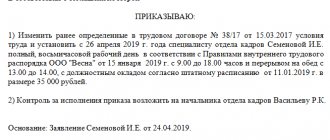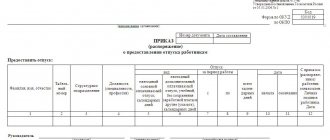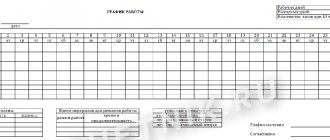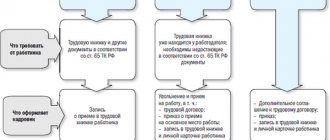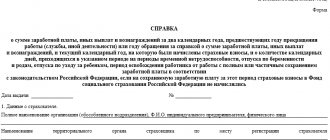If symptoms of coronavirus are detected in any of the employees, an Order is issued to remove the employee from work in connection with coronavirus on the basis of a report drawn up on the identification of an elevated body temperature in the employee or an extract from the thermometry log. In this case, when issuing an order, the manager is guided by the requirements of Article 76 of the Labor Code of the Russian Federation, the relevant Federal laws and letters of Rospotrebnadzor, decrees and resolutions of mayors and governors.
The basis for suspecting a coronavirus infection and issuing an order to remove an employee from work due to coronavirus is an elevated body temperature and the presence of other signs of the disease (dry cough, malaise, etc.). In this case, the employee should be sent home and monitored by the employee calling a doctor to the house. Any contact with other employees is excluded until complete recovery, confirmed by a medical document. The period of suspension from work is until the provision of a document from a doctor confirming recovery.
Conditions for legal removal from work
An employer cannot prohibit an employee from appearing at the workplace on his own initiative without dismissing him. All situations where a company is obliged to temporarily suspend an employee from performing his duties are strictly regulated by law. To them, according to Part 1 of Art. 76 of the Labor Code of the Russian Federation includes:
- showing up at work in a state of any kind of intoxication;
- ignoring medical examination, safety and labor protection instructions;
- the presence of medical contraindications to performing the assigned work;
- expiration/suspension of up to 2 months of documents giving the right to perform certain actions necessary to perform official duties;
- requirement of officials and supervisory organizations authorized by law.
There are also specific grounds for removal from work provided for in the Labor Code of the Russian Federation:
- expiration of a patent or work permit for a temporarily arrived foreign employee (paragraph 3, part 1, article 327.5 of the Labor Code of the Russian Federation);
- lack of personal protective equipment for an employee engaged in underground work (paragraph 3, part 1, article 330.4 of the Labor Code of the Russian Federation);
Other regulations may also provide for circumstances requiring mandatory removal of an employee from work.
All the nuances of the process of removal from work are disclosed in the material “Procedure and conditions for removal from work, including quarantine due to coronavirus.”
IMPORTANT!
The presence of one of the circumstances provided for by law imposes a direct obligation to restrict the employee’s access to the workplace. has no right not to do this at its own discretion .
Removal of an employee from work for medical reasons
A number of professions and positions require an initial and subsequent medical examination. For example, workers in the catering and food industry: salespeople, bartenders, cooks, waiters, support workers and others. Employees of educational institutions are required to undergo a psychiatric commission: kindergarten teachers, teachers of secondary and higher educational institutions, school teachers.
If an employee has not passed the necessary commission and has not received a proper medical certificate allowing him to work, then he may be suspended from work. If, during the next medical examination, he does not receive permission to work, he is also suspended from work until he receives an appropriate positive medical report.
Moreover, if an employee has been recognized as a disabled person of group 1 according to a medical and social examination and is incapacitated for work, then the employer can terminate the employment contract with him. If a disability of group 2 or 3 has not been established, and the person does not want to work anymore, then he can resign of his own free will (Article 80 of the Labor Code of the Russian Federation).
Find out about the procedure for dismissing an employee at your own request from our article “Procedure for dismissing at your own request” .
If the employee wishes to remain at work, the employer is obliged to create working conditions suitable for his further work activity in accordance with the individual rehabilitation program.
General procedure for drawing up an order for removal
There is no officially designated form for drawing up an administrative document on removal .
Before its publication, it is necessary to obtain a justification - an act, an official or memorandum, an official medical report or an order from a supervisory organization.
The order to remove an employee from work includes the following details:
- FULL NAME. employee;
- name of the reason for removal;
- an indication of the document that served as the basis for issuing the order;
- the duration of the ban on visiting the workplace;
- if the restriction applies only to certain duties (if the right to perform them is lost), it is necessary to provide a list of specific job functions.
The document also indicates that will not be paid wages during the suspension .
The employee must be familiarized with the order against signature. Also, if it mentions other persons (for example, an accountant) who must perform any actions, they should also be familiarized with the order.
IMPORTANT!
If the suspended person refuses to sign the order, an act should be drawn up to record this point.
Is it possible to fire an employee instead of suspending him?
Dismissal of a citizen due to contraindications to continuing work is possible, but only in individual cases and under the following conditions:
- the duration of the citizen’s contraindications is more than four months;
- the employer does not have other positions to which he could move the employee, or the employee refuses them.
The procedure for removing an employee applies to cases where the contraindications will last no more than four months, if they are longer, or if the employee requires a permanent transfer, and in the absence of other work - dismissal under Part 8 of Art. 77 Labor Code of the Russian Federation. This rule is enshrined in para. 3 tbsp. 73 Labor Code of the Russian Federation.
Upon dismissal on this basis, the employer pays the employee severance pay in the amount of two weeks' average earnings - such an obligation is established for the employer under Art. 178 Labor Code of the Russian Federation.
Is it necessary to issue an order for permission to work after suspension?
The period of suspension from work may be determined by a fixed date. But most often, the end of exclusion from performing labor functions is associated with the cessation of the circumstances that caused it. For example, suspension for failure to undergo a medical examination ends after the examination has been carried out and a conclusion has been issued by the medical commission. From this date the employee begins work.
Although the law does not require the issuance of an additional document, in practice it is still often formed. Like most such documents, the order for admission to work after suspension does not have a unified form. The organization develops it independently.
It must indicate:
- FULL NAME.;
- position of the person starting work;
- date of resumption of activity;
- grounds for termination of suspension;
- an indication of the need to start accruing salaries.
The employee going to work also gets acquainted with the order by signing it.
How to punish for violations
For an employer, a violation is:
- allowing an employee to work if he or she has health contraindications. Responsibility for this act is established by Parts 3 and 5 of Art. 5.27.1 of the Code of Administrative Offenses of the Russian Federation and implies punishment in the form of a fine for legal entities in the amount of 200,000 rubles or administrative suspension of activities for up to 90 days;
- errors in registering an employee’s challenge, in particular, providing alternative options if available. Such a violation is qualified under Part 1 or 2 of Art. 5.27 of the Code of Administrative Offenses of the Russian Federation and is punishable by a fine of up to 70,000 rubles.
Related documents
- Sample. Decision of the labor dispute commission regarding a reprimand for being late for work
- Sample. Certificate from place of work
- Sample. Tariff and qualification characteristics of the hotel director (Resolution of the Ministry of Labor of the Russian Federation dated January 20, 1994 No. 7 (as amended dated October 31, 1995 No. 60)
- Sample. Tariff and qualification characteristics of the director of the printing house (Resolution of the Ministry of Labor of the Russian Federation dated January 20, 1994 No. 7 (as amended dated October 31, 1995 No. 60)
- Sample. Tariff and qualification characteristics of the head of the hostel (Resolution of the Ministry of Labor of the Russian Federation dated January 20, 1994 No. 7 (as amended dated October 31, 1995 No. 60)
- Sample. Tariff and qualification characteristics of the canteen manager (Resolution of the Ministry of Labor of the Russian Federation dated January 20, 1994 No. 7 (as amended dated October 31, 1995 No. 60)
- Sample. Tariff and qualification characteristics of the calculator (Resolution of the Ministry of Labor of the Russian Federation dated January 20, 1994 No. 7 (as amended dated October 31, 1995 No. 60))
- Sample. Tariff and qualification characteristics of the codifier (Resolution of the Ministry of Labor of the Russian Federation dated January 20, 1994 No. 7 (as amended dated October 31, 1995 No. 60))
- Sample. Tariff and qualification characteristics of the head (manager) of the workshop (Resolution of the Ministry of Labor of the Russian Federation dated January 20, 1994 No. 7 (as amended dated October 31, 1995 No. 60)
- Sample. Tariff and qualification characteristics of the head of a motorcade (resolution of the Ministry of Labor of the Russian Federation dated January 20, 1994 No. 7 (as amended dated October 31, 1995 No. 60)
- Sample. Tariff and qualification characteristics of the garage manager (Resolution of the Ministry of Labor of the Russian Federation dated January 20, 1994 No. 7 (as amended dated October 31, 1995 No. 60)
- Sample. Tariff and qualification characteristics of the operator for dispatch service of elevators (Resolution of the Ministry of Labor of the Russian Federation dated January 20, 1994 No. 7 (as amended dated October 31, 1995 No. 60)
- Sample. Tariff and qualification characteristics of a passport officer (Resolution of the Ministry of Labor of the Russian Federation dated January 20, 1994 No. 7 (as amended dated October 31, 1995 No. 60)
- Sample. Tariff and qualification characteristics of the secretary of a blind specialist (Resolution of the Ministry of Labor of the Russian Federation dated January 20, 1994 No. 7 (as amended dated October 31, 1995 No. 60))
- Sample. Tariff and qualification characteristics of a taxi driver (Resolution of the Ministry of Labor of the Russian Federation dated January 20, 1994 No. 7 (as amended dated October 31, 1995 No. 60))
- Sample. Employment agreement (contract) with the director of a commercial bank (open joint stock company)
- Sample. Employment agreement (contract) with an employee of a joint-stock company
- Sample. Employment agreement (contract) with the manager (head of a structural unit) of the joint-stock company
- Sample. Employment contract with an employee of a closed joint stock company
- Sample. Employment contract with an employee of a limited liability company for the duration of a specific job (short)
Document form
The law does not establish the form of an order to remove an employee from work. Organizations are encouraged to rely on samples of administrative documents developed and approved at the local level.
The order is issued on the organization’s letterhead (if it uses it) or on a regular A4 sheet. If the order is issued on letterhead, it will already contain all the basic details of the organization, otherwise in the “header” of the order you will need to indicate the name of the employer (name of the organization), address, for legal entities - KPP/TIN.
The order consists of the following mandatory elements:
- name of the order;
- preamble, which indicates the names and numbers of the documents that became the basis for its preparation (articles of the Labor Code, other federal and local regulations, numbers and dates of medical reports, acts, etc.);
- the word “I command” located below the preamble in the center;
- the text of the order, starting with the words “suspension from work for a period from... and until...”. The full last name, first name and patronymic of the employee, position and structural unit, and reason for removal must be indicated;
- a note that the accounting department does not pay for the time of suspension (if this is the case);
- a note about the person who is entrusted with familiarizing the employee with the order;
- position, signature and transcript of the signature of the manager who signed the order.
After signing by the manager, the order is assigned a registration number.
Procedure for removing an employee
According to the law, removal from the performance of duties by an employee can be temporary until the reasons are completely eliminated, which often depends on the type of business of the enterprise; for example, a municipal employee can only be suspended for a period of up to 31 days with cash pay.
There are no uniform deadlines for all cases. If the reason cannot be eliminated and the suspension may turn into a regular action, it is necessary to transfer the employee to another place of work or dismiss him on the basis of legitimate reasons.
When planning to perform these actions in relation to an employee, the manager must be regulated by local acts of the enterprise, taking into account the specifics of the case.
Important: in some cases it is permissible to use an abbreviated system, for example, in transport.
The entire procedure depends on the reason; initially it is necessary to obtain supporting documents - the basis for such a decision.
Form of order to remove an employee.
Eg:
- Drunkenness at Work Act;
- Conclusion of the commission on professional incompetence;
- Medical opinion;
- Inspector's order;
- Other documents.
A written explanation should be required from the offending person. Based on the documents obtained during the internal investigation, a dismissal order is issued.
The document is generated in any form indicating the main points:
- Circumstances of dismissal of a specific employee – full name, position;
- List of supporting documents;
- The period of inadmissibility can only be specified if there is confidence that the situation will really change;
- Specify an authorized person to control the entire process.
Payment during this period
Important: no payments are made during this period. However, there are exceptions to the general rule:
- Payment as for downtime occurs if the employee has not undergone a medical examination or instructions on labor protection due to the fault of the employer;
Important: suspension due to the fault of the employer for failing to pass a medical examination is included in the length of service.
- If the incident occurred due to charges of a crime, the employee receives payments from the state in the amount of 5 minimum wages - they are intended to cover legal costs.
If the order is violated or the removal is illegal
In case of non-compliance with the dismissal procedure, there is no documentary evidence of the reason that led to the dismissal, the employer bears administrative responsibility.
He will have to pay a fine of 50,000 rubles, plus disqualification followed by a ban on engaging in his chosen activity.
In addition, it is necessary to pay the employee all funds for days of downtime in the amount of average daily earnings.
Important: if documents and reasons that are not provided for by law are used as a reason for removal, then it is illegal.
Arbitrage practice
If an employee does not agree with the employer’s decision and considers it illegal, he has the right to go to court.
What the plaintiff (employee) can demand:
- recognition of the illegality of the order;
- recovery of lost wages, average earnings, amounts for downtime that occurred due to the fault of the employer;
- reinstatement (if the suspension was followed by dismissal);
- changes to the entry in the work book if he was fired;
- compensation for moral damage and reimbursement of expenses for defense services.
Experience has shown that if an employer makes mistakes in the removal procedure, then the likelihood of winning the case in court is quite high.
Illegal removal
In labor law, suspension from work may be illegal. This means every reason not provided for by law, or the absence of sufficient grounds.
According to the norms of the Labor Code, then the employer compensates his employee for lost earnings. He may also incur disciplinary liability - a fine, disqualification, suspension of activities.
Is it possible to challenge?
Employees suspended from work rarely agree with the employer's decision, but in what cases do they have the right to challenge it?
To find out, you need to consider the illegal grounds for removal from work. The list includes all the employer’s requirements that are not supported by the labor legislation of the Russian Federation. The latter are listed above. To be sure that you are right, you can contact a qualified lawyer for advice.
If an employee is suspended from work illegally, he can contact the labor inspectorate with a request to reinstate him in his previous position and/or challenge the employer’s order. An alternative option is to file a claim to cancel the suspension in the magistrate’s court at your place of residence or workplace address.
In both cases, if the plaintiff is proven right, this will be followed by one of the following scenarios (a detailed list is given in Article 394 of the Labor Code of the Russian Federation):
- reinstatement in the previous position;
- payment to the employee of wages for the entire period of forced absence, or the corresponding difference if there was a reduction in the salary paid;
- changing the wording of the reason for suspension/dismissal;
- changing the date of suspension/dismissal;
- monetary compensation for moral and material damage.
In order for an employee to be reinstated after a contested suspension, the employer issues an order terminating the effect of the decision that gave rise to the dispute.
Employee intoxication report
To create an act, a special commission is assembled, which assesses the employee’s condition and establishes criteria by which the presence of one of the types of intoxication can be accurately confirmed. The act can be drawn up without the participation of doctors if the members of the special commission can clearly determine the worker’s drunken state based on the existing signs.
To create a commission for drawing up an act, an order is formed, which indicates information about the composition of the commission and a list of tasks that are assigned to them. The contents of the order are conveyed to each member of the commission against signature.
Next, the commission must assess the employee’s condition as quickly as possible and record the fact of intoxication in the report; this action must be carried out as early as possible on the day when this violation was noted.
If an act is not drawn up within the next few hours from the moment the employee’s drunken state is discovered, then it will be much more difficult to prove the fact of intoxication.
The act must include the following information, presented in free form:
- Date the violation was recorded;
- Exact time of detection of employee intoxication;
- Place of execution of the act;
- Information about the offender;
- Signs of intoxication detected by the commission members (smell, slurred speech, swaying gait, change in complexion);
- The conclusion of the commission on the presence of intoxication in the designated person;
- Information about the persons drawing up the act.
It is important not to confuse the state of intoxication with manifestations of the disease, since all the above signs are also characteristic of a painful state. If in doubt, it is better to seek the help of medical professionals.
Example of an act:
The act is handed over to the intoxicated worker for review and signature. It is also recommended to immediately invite the employee to write an explanatory note, the content of which will confirm the violation of the employee’s thought process, incoherence and inconsistency of speech.
If a decision is made to remove an employee from work, an order is drawn up. The order must contain;
- Information about the employee for whom the violation was recorded;
- Order to suspend from work;
- Circumstances for removal;
- List of supporting documents;
- The period of suspension is determined by the medical examination protocol; if one has not been drawn up, it is determined by the supervisor, based on the person’s condition, the degree and cause of his intoxication.
The order is approved by the signature of the manager and handed over to the suspended employee for review against signature. For this violation, the employer has the right not only to not allow the employee to work until he sobers up, but also to fire him under Article 81. Labor Code of the Russian Federation.
Example of an order:
conclusions
An employee can be suspended from work only in cases established by law. If it is impossible to justify from the point of view of law the grounds for removing an employee from work, he CANNOT be suspended.
Illegal removal of an employee from work entails the employer being held administratively liable; in addition, if the employee goes to court, he will also have to pay for the period of suspension and moral damages to the employee.
The removal procedure is quite simple; you need a reason (preferably a memo) and an order.
Before issuing the order, the main thing is not to forget to offer the vacant position to the employee in writing and signed.
What about the salary during the suspension?
During the period of suspension from work (preclusion from work), the employee’s salary is not accrued (Part 3 of Article 76 of the Labor Code of the Russian Federation) - as a general rule. Exceptions are established separately by regulations.
If an employee has not undergone training and testing of knowledge and skills in the field of labor protection or a mandatory medical examination not through his own fault, but, say, due to the fact that the employer did not organize a medical examination or training, then the entire time of suspension from work is paid to the employee as idle time.
In accordance with Art. 157 of the Labor Code of the Russian Federation, downtime due to the fault of the employer is paid in the amount of at least 2/3 of the average salary of the employee, for reasons beyond the control of the employer and employee - in the amount of at least 2/3 of the tariff rate, salary (official salary), calculated in proportion to the time just me.
Downtime caused by the employee is not paid.
If a civil servant is suspended from work from a civil service position to be filled for the period of resolving a conflict of interest or conducting an audit, he will retain his salary for the entire period of suspension (Article 32 of Law No. 79-FZ).
It is also worth noting that in accordance with Part 2 of Article 121 of the Labor Code of the Russian Federation, the time of suspension is not included in the length of service required to grant leave.


